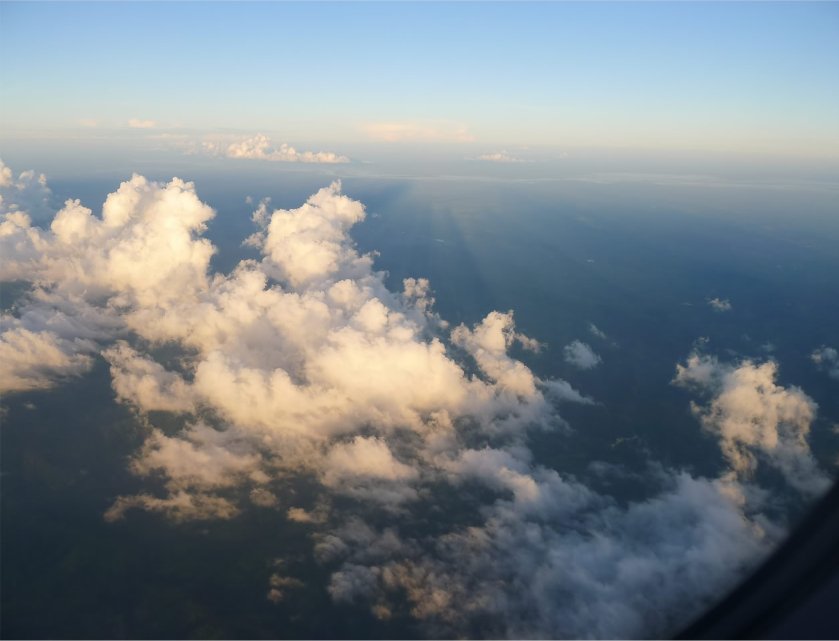OPOD - Rays Shadows Colours
OPOD - Rays Shadows Colours: A Fascinating Display of Atmospheric Optics
Atmospheric optics never ceases to amaze us with its captivating displays. One such phenomenon is the interplay of rays, shadows, and colors in the sky. Mario Freitas, an observer from UTFPR Curitiba, Brazil, captured a remarkable scene during a flight from Bogota to Cartagenia. As sunset approached, he witnessed an unusual aspect of cloud rays and shadows that revealed the true nature of these atmospheric phenomena.
Cloud tops, responsible for casting shadows, were clearly discernible as tubes of unlit air stretching for tens and sometimes hundreds of miles. These shadow tubes create a mesmerizing effect as they slope gently downwards, appearing parallel but converging to a point due to perspective. When viewed sunward, they converge on the sun itself, giving rise to the renowned "crepuscular rays." Conversely, when observed in the opposite direction, they converge at the antisolar point, forming what are known as "anticrepuscular" or "antisolar" rays.
From the ground, these rays and shadows would appear as if they radiate outward from the near setting sun, seemingly projecting upwards into the sky. It's a breathtaking sight that adds a touch of magic to the natural world.
But there's more to this atmospheric spectacle than just rays and shadows. Mario's images also provide a captivating study in cloud and atmospheric colors. Cloud tops still bathed in direct sunlight exhibit yellow and rosy hues, reflecting the reddened light of the low sun. Meanwhile, aerosols and dust present in the sunlit atmosphere scatter the same light, giving rise to the ethereal "rays" that fill the spaces between the dark shadow tubes.
However, it's when we turn our attention to the lower clouds deep in shadow that we encounter a fascinating interplay of colors. These shadowed clouds appear blue-grey because they are solely illuminated by the blue skylight. In contrast, the shadowed clouds situated near the sunlit ones exhibit a purplish-pink hue. This unique coloration arises from a combination of blue skylight and the reflection of yellow and red rays from the sunlit cloud surfaces surrounding them.
As we shift our gaze to the distant sky near the horizon, we notice its almost white appearance. This phenomenon can be attributed to the presence of aerosols and dust haze, which have reached an optical thickness that causes incident sunlight to undergo multiple scattering. The result is a near-whitening of the sky as the scattered light permeates through the atmosphere.
In conclusion, the captivating display of rays, shadows, and colors in the atmosphere never fails to astound us. From the intriguing convergence of shadow tubes to the interplay of hues reflecting the low sun, these phenomena offer a glimpse into the intricate workings of atmospheric optics. Whether observed from a plane or from the ground, these enchanting displays serve as a reminder of the beauty and complexity of our natural world. So next time you find yourself gazing at the sky during sunset or sunrise, take a moment to appreciate the magic that unfolds above us.

Rays - Shadows - Colours
Mario Freitas (site) of UTFPR Curitiba, Brazil caught this unusual aspect of cloud rays and shadows during a flight from Bogota to Cartagenia. Sunset was approaching.
The cloud tops responsible for the shadows are clearly discernible as is the shadows' true nature – tubes of unlit air stretching for tens and sometimes hundreds of miles. Compare the appearance of mountain shadows. ©Mario Freitas, shown with permission

Close to sunset the shadow tubes cast by clouds slope gently downwards. They are parallel but appear by perspective to converge to a point. Viewed sunward they converge on the sun itself as 'crepuscular rays'. Viewed in the opposite direction (as above) they converge at the antisolar point as 'anticrepuscular' or 'antisolar' rays.
From the ground in Mario's upper image the rays and shadows might look something like this - shadows radiating outwards from the near setting sun and appearing to project upwards into the sky.
Below: A study in cloud and atmospheric colours. Cloud tops still in direct sunlight have yellow and rosy hues reflecting the reddened light of the low sun. Aerosol and dust in the sunlit atmosphere backscatters the same light to form the 'rays' between the dark shadow tubes. At right, lower clouds deep in shadow look blue grey because they are lit purely by blue skylight. In contrast, shadowed clouds at right is a purplish pink - they are lit by a combination of blue skylight and yellow/red rays reflected from the sunlit cloud surfaces around them. The distant sky near the horizon is almost white because the aerosol and dust haze is approaching an optical thickness when incident sunlight is multiply scattered.

Note: this article has been automatically converted from the old site and may not appear as intended. You can find the original article here.
Reference Atmospheric Optics
If you use any of the definitions, information, or data presented on Atmospheric Optics, please copy the link or reference below to properly credit us as the reference source. Thank you!
-
<a href="https://atoptics.co.uk/blog/opod-rays-shadows-colours/">OPOD - Rays Shadows Colours</a>
-
"OPOD - Rays Shadows Colours". Atmospheric Optics. Accessed on November 26, 2024. https://atoptics.co.uk/blog/opod-rays-shadows-colours/.
-
"OPOD - Rays Shadows Colours". Atmospheric Optics, https://atoptics.co.uk/blog/opod-rays-shadows-colours/. Accessed 26 November, 2024
-
OPOD - Rays Shadows Colours. Atmospheric Optics. Retrieved from https://atoptics.co.uk/blog/opod-rays-shadows-colours/.